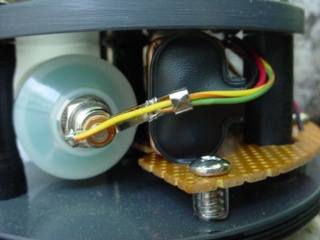
Note how the sensor connector passes over battery connection. The sensor is the last part to be connected to the circuit, and the first component to be disconnected from the circuit.
Crestline Experimental Dive Unit
Additional Information and Pictures
of FEOR Light's
Heads Down Display
Sensor and Battery Connectors
Close up of Sensor and Battery Connectors.

Note how the sensor connector passes over battery connection. The sensor is the
last part to be connected to the circuit, and the first component to be
disconnected from the circuit.
An important note from page 38 of Forrest Mimms/Timer, Op Amp & Optoelectric Circuits & Projects (book # 62-5032) concerning Powering Op-Amps states: "Never apply an input signal when the power supply is switched off."

In this circuit I have taken that advice, blindly for lack of other qualifying information, and because I have damaged some Integrated Circuits during this development process. The HDD Module is designed such that the Oxygen Sensor which generates the input signal (voltage) can only be connected to the circuit after the battery is connected. Likewise it needs to be removed from the circuit before the battery is disconnected.
I would like to ask some questions of you electronics professionals who may read this;
(1) What do I need to do, to protect the OpAmp from the potential damage the input signal can cause,
(2) What damage can it cause, and/or
(3) Do I really need to be that concerned about it considering the small voltages we are dealing with?
I would also like to ask some of you users of store-bought rebreather what advice, if any, is given by the manufacturers of your units.
Email me at doctrbob@gte.net, or discuss it on the Northwood Designs Mailing List if you wish. Thanks.
Everything I do is a learning process, every dive is more than an adventure, it is a wet bio-mechanical experiment!
The Heads Down Display in Operation and Observations

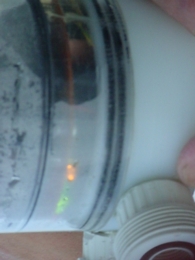
The HDD in the FEOR Light, Pre and Post Dive.
(Note condensation formation in inside of scrubber canister post dive.)
The HDD worked. As you see from some of the post dive images of the unit, condensation forms on the inside of the canister. If your scrubber is not clear, you may not be aware of this fact. My electronics pod is in an ambient, and what is considered a condensing environment. (Yes, it should be potted or some other way isolated. That will come later, see below.)
Diving with displays within the canister, where condensation has formed, I have discovered that it is easier for me to detect the color of the LED's better than it is to read numbers on the digital LED Display. I like this feature. The information delivered by the colors were received and acknowledged even before my eye was able to focus on the display, which means that the information can be used even if it out of your direct field of vision. (This can imply that you may never have to actually look directly at a display to use the information it conveys. LED's could be placed on the periphery of your field of vision, on masks or within helmets. (The purposeful monitoring of discrete digital/analog information can be a secondary action when necessary.)
Another subjective observation is that it seems that it seems to takes
less time to determine what corrective action needs to be taken using a Color
(LED) as a reference than it takes reading numbers from the digital Display.
If I see Green, all "should be" OK, no action necessary. Only if I see Red, or
a Yellow by itself there something that needs to be done. If only Yellow,
than add Oxygen. If Red is noted, then "Stop" and figure out what is going
on. While using the digital display, it seems that mental processing involved
first reading the numbers, second deciding if the PPO2 displayed was where it
should be, if not than next decide what, if anything needs to be done, and
finally taking the corrective action. This appears like more steps overall.
"CEDU Glass" our first "Potting" job.
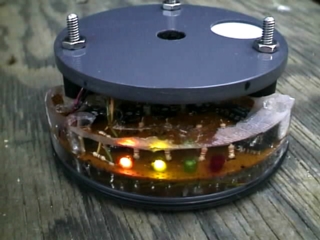
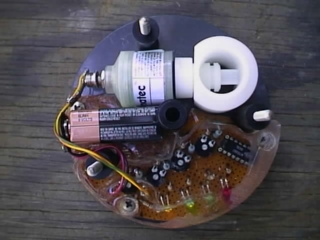
Potted electronics in HDD Sensor Module.
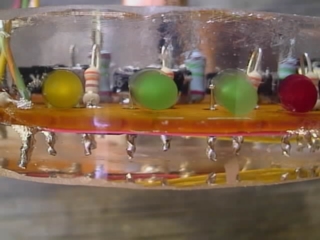
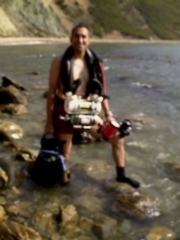
Close up of "Optically Clear and Magnifying" surface.
(And wide angle of optically blurry post
test dive picture.)
The HDD was finally "Potted" within a clear plastic material currently called "CEDU Glass", (a proprietary formulation and process) using a vacuum, pressure and temperature controlled manufacturing system. Yes, this first attempt is somewhat crude, but it worked. Optical clarity and magnification was accomplished. (Please note the absence of manufacturers marks. In certain circles we must be able to deny that the CEDU had anything to do with this piece of technology! But for the right price we can put any name, logo or trademark that you request. Contact the engineering department for details and rates.)
A test dive of the potted circuit was conducted on 7/14/02 at Cardiac Hill, Palos Verdes a few miles from Malaga Cove.
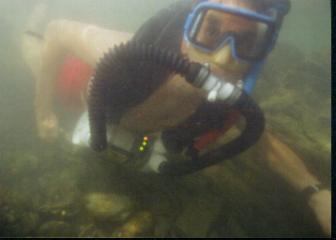
Results uneventful. Everything seemed to work, no leaks. The vis was poor
and the surge was heavy. Not a fun dive, except for the fact that the water
temperature was warm, about 67 degrees, and I had a nice swim after the dive.
This dive was conducted in swim trunks only, thus it was mo'easy to see
the display because my range of (head) motion was greater. (No neoprene hood to
restrict it.).
Some other little experiences..
A battery terminal on a 9 volt battery broke off. (Manufacturing flaw? Luck of
the draw?)
A battery terminal clip on the battery connection loosened up resulting in an
occasional open condition when rattled, even after a pronounced "snap" when
attached to the battery. (Guess they loosen up with use, I found you can pinch
them in a little and they hold tighter..)
More information about Rebreathers/SUBLIME/and the CEDU
can be found starting at
Dr. Bob's The Home Page
"To Swim Is Human, To Dive Is SUBLIME"
And Remember CEDU's Mission Statement:
"To Design, Assemble and Use Homemade Dive Gear While Maximally Stroking Our
Own Ego's and Maintaining the Merest Semblance of Sobriety for the Benefit of
Mankind"